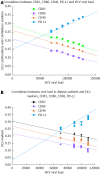Dendritic cell co-stimulatory and co-inhibitory markers in chronic HCV: an Egyptian study
- PMID: 24282359
- PMCID: PMC3837270
- DOI: 10.3748/wjg.v19.i43.7711
Dendritic cell co-stimulatory and co-inhibitory markers in chronic HCV: an Egyptian study
Abstract
Aim: To assess co-stimulatory and co-inhibitory markers of dendritic cells (DCs) in hepatitis C virus (HCV) infected subjects with and without uremia.
Methods: Three subject groups were included in the study: group 1 involved 50 control subjects, group 2 involved 50 patients with chronic HCV infection and group 3 involved 50 HCV uremic subjects undergoing hemodialysis. CD83, CD86 and CD40 as co-stimulatory markers and PD-L1 as a co-inhibitory marker were assessed in peripheral blood mononuclear cells by real-time polymerase chain reaction. Interleukin-10 (IL-10) and hyaluronic acid (HA) levels were also assessed. All findings were correlated with disease activity, viral load and fibrogenesis.
Results: There was a significant decrease in co-stimulatory markers; CD83, CD86 and CD40 in groups 2 and 3 vs the control group. Co-stimulatory markers were significantly higher in group 3 vs group 2. There was a significant elevation in PD-L1 in both HCV groups vs the control group. PD-L1 was significantly lower in group 3 vs group 2. There was a significant elevation in IL-10 and HA levels in groups 2 and 3, where IL-10 was higher in group 3 and HA was lower in group 3 vs group 2. HA level was significantly correlated with disease activity and fibrosis grade in group 2. IL-10 was significantly correlated with fibrosis grade in group 2. There were significant negative correlations between co-stimulatory markers and viral load in groups 2 and 3, except CD83 in dialysis patients. There was a significant positive correlation between PD-L1 and viral load in both HCV groups.
Conclusion: A significant decrease in DC co-stimulatory markers and a significant increase in a DC co-inhibitory marker were observed in HCV subjects and to a lesser extent in dialysis patients.
Keywords: CD83; CD86, CD40; Dendritic cells; Hemodialysis; Hepatitis C virus; Hyaluronic acid; Interleukin-10; PD-L1; Uremia.
Figures




Similar articles
-
Monocyte-derived dendritic cells from chronic HCV patients are not infected but show an immature phenotype and aberrant cytokine profile.Liver Int. 2007 Sep;27(7):944-53. doi: 10.1111/j.1478-3231.2007.01507.x. Liver Int. 2007. PMID: 17696933
-
Influenza Virus Hemagglutinin Glycoproteins with Different N-Glycan Patterns Activate Dendritic Cells In Vitro.J Virol. 2016 Jun 10;90(13):6085-6096. doi: 10.1128/JVI.00452-16. Print 2016 Jul 1. J Virol. 2016. PMID: 27099319 Free PMC article.
-
Contradictory intrahepatic immune responses activated in high-load hepatitis C virus livers compared with low-load livers.Arch Virol. 2018 Apr;163(4):855-865. doi: 10.1007/s00705-017-3675-8. Epub 2017 Dec 16. Arch Virol. 2018. PMID: 29248968
-
Gamma-Chain Receptor Cytokines & PD-1 Manipulation to Restore HCV-Specific CD8+ T Cell Response during Chronic Hepatitis C.Cells. 2021 Mar 3;10(3):538. doi: 10.3390/cells10030538. Cells. 2021. PMID: 33802622 Free PMC article. Review.
-
Costimulatory molecule programmed death-1 in the cytotoxic response during chronic hepatitis C.World J Gastroenterol. 2009 Nov 7;15(41):5129-40. doi: 10.3748/wjg.15.5129. World J Gastroenterol. 2009. PMID: 19891011 Free PMC article. Review.
Cited by
-
Humanized Mice as an Effective Evaluation System for Peptide Vaccines and Immune Checkpoint Inhibitors.Int J Mol Sci. 2019 Dec 16;20(24):6337. doi: 10.3390/ijms20246337. Int J Mol Sci. 2019. PMID: 31888191 Free PMC article. Review.
-
Hyaluronic acid as a biomarker of fibrosis in chronic liver diseases of different etiologies.Clujul Med. 2016;89(1):24-31. doi: 10.15386/cjmed-554. Epub 2016 Jan 15. Clujul Med. 2016. PMID: 27004022 Free PMC article. Review.
-
Recent Findings in the Regulation of Programmed Death Ligand 1 Expression.Front Immunol. 2019 Jun 14;10:1337. doi: 10.3389/fimmu.2019.01337. eCollection 2019. Front Immunol. 2019. PMID: 31258527 Free PMC article. Review.
-
Mononuclear phagocyte system in hepatitis C virus infection.World J Gastroenterol. 2018 Nov 28;24(44):4962-4973. doi: 10.3748/wjg.v24.i44.4962. World J Gastroenterol. 2018. PMID: 30510371 Free PMC article. Review.
References
-
- Guerra J, Garenne M, Mohamed MK, Fontanet A. HCV burden of infection in Egypt: results from a nationwide survey. J Viral Hepat. 2012;19:560–567. - PubMed
-
- Sievert W, Altraif I, Razavi HA, Abdo A, Ahmed EA, Alomair A, Amarapurkar D, Chen CH, Dou X, El Khayat H, et al. A systematic review of hepatitis C virus epidemiology in Asia, Australia and Egypt. Liver Int. 2011;31 Suppl 2:61–80. - PubMed
-
- Khodir SA, Alghateb M, Okasha KM, Shalaby Sel-S. Prevalence of HCV infections among hemodialysis patients in Al Gharbiyah Governorate, Egypt. Arab J Nephrol Transplant. 2012;5:145–147. - PubMed
MeSH terms
Substances
LinkOut - more resources
Full Text Sources
Other Literature Sources
Research Materials

